 Image search results - "child" Image search results - "child" |

From late April to early May, five long strings of giant carp streamers swim in the air high above the Sagami River in Sagamihara, Kanagawa. This event was started in 1988.
|
|

The festival is held along a straight, 800-meter section of San'o Odori Road, a 20-min. walk from Akita Station.In the evening, the main event starts at 6:38 p.m. with a taiko drum-beating performance or minyo dancers on San'o Odori Road. At 7:17 p.m., some 200 kanto are carried into the street to the sound of flutes and taiko drums. At 7:40 p.m. following a brief address by the city's mayor, the performance begins as the kanto are raised all at once.
|
|

Pulling the float, Narita Gion Matsuri
|
|

There are five rows of streamers. In Japan, the koi carp is regarded as a symbol of valiant manhood because it swims up the river against the rapids.
|
|

Children lead the way for a float at Kawagoe Festival.
|
|

Tired from walking, Narita Gion Matsuri
|
|

The cable length is 250 meters and 13mmm thick. There are about 1,200 carp streamers. They are reused every year and donated by local families. (I also noticed a few advertising carps.)
|
|

Lead float with Edo festival music played by children. The names of the children playing are written on the red lanterns hanging above. Kodomo Edo-bayashi yatai 先導 子供江戸囃子屋台
|
|
|
|

The procession basically consists of two columns: The Hon-retsu which includes the procession's highest-ranking official called Chokushi. It consists of men. The second and longer column is the Saio-dai-retsu consisting of women.
|
|

The floats were jerked left and right and spun around.At 7:00 p.m., the taiko drum-beating started and the floats left the starting point one by one. The beat of the taiko drums was the same as that in the Nebuta Matsuri. A few men stood on the top of the large Neputa and collapsed the hinged, top portion to clear overhead power lines. The floats were jerked left and right and spun around.
|
|
|
|
|
|

Sagami River Koi-nobori
|
|
|
|
|
|

Kawagoe Festival
|
|

Children dressed for the chigo parade (photo session), Tsukiji Hongwanji, Tokyo
|
|
|
|

The longest carp is 10 meters.
|
|

Magistrate Procession 奉行
|
|
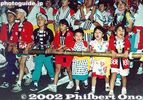
Children's night at Aomori Nebuta MatsuriOn the 2nd and 3rd, the parade is mainly for children who participate by pulling the floats. About 15 large Nebuta floats and some small Nebuta floats for the children are paraded.
|
|

Narita Gion Matsuri
|
|
|

Narita Gion Matsuri
|
|

Along the river were food stalls.
|
|
|
|

Festival site
|
|
|

Cable anchor
|
|
|
|
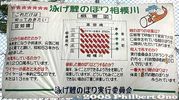
Statistics
|
|

Nice during the day, but more dramatic at night.
|
|
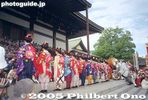
Offering prayers at Narita Gion Matsuri
|
|
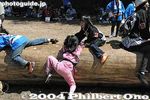
Here is where anybody can get on the logs and play.
|
|

Narita Gion Matsuri
|
|
|

Carp streamer caught at Kanna-machi, Gunma
|
|
|
|

Hitsujiyama Park with weeping cherry blossoms
|
|

Sumo match with kidsA retirement ceremony for an important sumo wrestler includes a variety of activities besides the actual ceremony of cutting away the topknot. It involves almost the entire Japan Sumo Association, and most wrestlers in the top three divisions (Makushita, Juryo, and Makunouchi) also appear in exhibition matches.
|
|
|
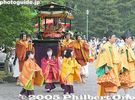
The Saio-dai Princess in 2005 was Saito Ayako, a 21-year-old Kyoto native and student at Doshisha Univ. Her 12-layer juni-hitoe kimono weighs 30 kg. 斎王代、齋藤彩子さん(21)The Saio-dai Princess is selected every year in April and a press conference is held to announce who was chosen. She is always a native of Kyoto, single, and in her early 20s. The Saio-dai was first incorporated in the festival in 1956. In 2005, she is the 50th Saio-dai.
Read more about here.
|
|

Kami shibai storyteller 紙芝居
|
|

A retirement ceremony for an important sumo wrestler includes a variety of activities besides the actual ceremony of cutting away the topknot. It involves almost the entire Japan Sumo Association, and most wrestlers in the top three divisions (Makushita, Juryo, and Makunouchi) also appear in exhibition matches.
|
|
|

Narita Gion Matsuri
|
|

Lion for good luck.
|
|
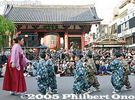
Tokyo Jidai Matsuri 三社大権現祭礼 船渡御
|
|

"Hey Ho, Let's Go!"
|
|
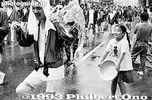
Splash you. This is a day when kids can be mean to grown-ups. This little girl kept filling up her bowl and ran around splashing some unlucky person.I hope that's her school teacher.
|
|

Special section for younger kids.
|
|

The man at the corner makes sure the kids obey the traffic rules.
|
|
|
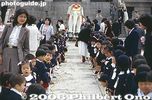
Many little kids held a long rope to pull the white elephant. 昔の築地本願寺の花まつり
|
|
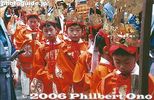
Chigo children 稚児, Nikko
|
|
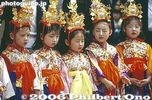
Chigo children. They have two black dots on the forehead and a white stripe on the nose. They don't paint the white stripe today. 昔の築地本願寺の花まつり: 鼻に白い線が塗っている。今は、塗らない。
|
|

Chigo children. 昔の築地本願寺の花まつり
|
|
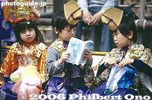
Chigo children. 昔の築地本願寺の花まつり
|
|
|
|

Shrine maidens
|
|

Look at all those Cub Scouts. They don't participate today. 昔の築地本願寺の花まつり
|
|
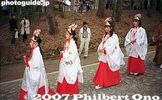
Shrine maidens
|
|

Shrine maidens
|
|

Kusatsu Shukuba Festival, Shiga Pref.
|
|
|
|
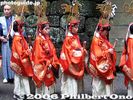
Chigo children wearing an elaborate crown with the signs of the eto Oriental Zodiac. NikkoNikko Grand Spring Festival in May.
|
|
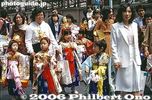
昔の築地本願寺の花まつり
|
|

Lion dance
|
|
|
|
|
|
|

Children dressed as tekomai, Sanno Festival.
|
|

Hanagasa umbrella dancers 花傘
|
|

Hanagasa umbrella dancers, Tenjin Matsuri, Osaka 花傘
|
|
|
|
|

Chigo child
|
|

Mother and twins in yukata
|
|

Kawaii!!
|
|
|
|
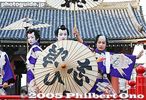
1624: Saruwaka Sanza, Edo Kabuki. Kabuki was started in the early Edo Period in 1624. Later, Edo's three licensed kabuki theaters named the Nakamura-za, Ichimura-za, and Morita-za were relocated to Asakusa in an area called Saruwaka."Sanza" means three theaters. 猿若三座 江戸歌舞伎
|
|
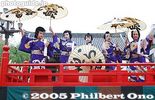
Saruwaka Sanza, Edo Kabuki. "Sanza" means three theaters. 猿若三座 江戸歌舞伎猿若三座 江戸歌舞伎
|
|

Saruwaka Sanza, Edo Kabuki猿若三座 江戸歌舞伎
|
|

The oiran courtesan is escorted by two little girls called kamuro. 花の吉原おいらん道中
|
|

Asakusa Folk Entertainment. Behind the Asakusa Temple, there was a variety of shows, street performers, plays, and other characters. Asakusa has always been Tokyo's entertainment center. 浅草奥山風景
|
|

Tekomai Children, Hie Shrine, TokyoHie Shrine in Tokyo holds the annual Sanno Festival in June. It consists of a parade and ceremony at the shrine. These children are dressed as tekomai geisha who originally provided side entertainment at festivals.
|
|
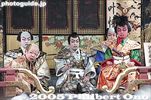
Hikiyama Festival, Nagahama, Shiga PrefectureHeld in mid-April, the Hikiyama Festival features authentic kabuki plays performed by young boys. Several ornate floats on wheels move around the city to serve as portable stages for these well-trained actors. The boys play both the male and female roles and wear gorgeous kimono. They undergo rigorous practice sessions during the months before the festival.
See more photos of this festival here.
|
|

Asakusa Hana Matsuri 花まつり
|
|

They sang a few songs. Their parents toting video camcorders recorded the event.
|
|

GumQ kids are very well trained.
|
|

Full of pep and vitality. Great for basketball games.
|
|

The tower is 333 meters high, with two observatories. The lower one, called the Main Deck, is 150 meters high. The higher one, the Top Deck, is 250 meters up.
|
|

Tokyo Tower has a number of evening illumination themes. This is the "Diamond Veil" illumination.
|
|
|
|

In early May for Children's Day, Tokyo Tower was festooned with colorful koinobori carp streamers.
|
|
|
|
|

Tokyo Tower with koinobori carp streamers in early May.
|
|

Tokyo Tower with koinobori carp streamers in early May.
|
|
|
|
|
|
|
|
|
|
|

Tokyo Tower with koinobori carp streamers in early May.
|
|

A real crowd pleaser. Beautiful and photogenic.
|
|
|
|
|
|
|

Tokyo Tower with koinobori carp streamers in early May.
|
|
|
|
|
|
|
|
|
|
|
|
|
|
|
|
|
|
|
|
|
|

Elevator for the Main Deck.
|
|

Ticket for the Main Deck.
|
|

It wasn't a long wait for the elevator.
|
|

Inside the elevator.
|
|

Main Deck had a cherry blossom-theme projection mapping on the windows.
|
|
|
|
|
|
|
|
|
|

Main Deck at Tokyo Tower. Despite the opening of Tokyo Skytree, Tokyo Tower is still holding its own with innovative attractions.
|
|

Tourists loved to pose with the projection mapping imagery.
|
|
|

Long line for the down elevators.
|
|

Tokyo Tower celebrating its 60th anniversary in 2018.
|
|
|
|
|
|
|

Restaurant on the Main Deck.
|
|

End of the line on the Main Deck for the Down elevator.
|
|

1st floor elevator.
|
|

Near the elevators on the 1st floor is this exhibition space.
|
|
|

A mysterious baseball was found on the top of Tokyo Tower.
|
|
|
|
|

Yatsu-kaeshi-no-Mai. 八つ換しの舞
|
|

Kodaiko drummers of the small taiko drum. 小太鼓
|
|

Niu Chawan Matsuri, Yatsu-kaeshi-no-Mai. 八つ換しの舞
|
|

Very impressive.
|
|

Many of the dancers wore waraji-related things.
|
|

This girl's homemade happi coat says "Waraji Matsuri."
|
|

Naginata Hoko and chigo child 稚児長刀鉾
|
|
|
|
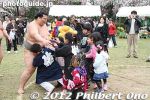
Sumo wrestler with kids at Toshi Nogyo Park in Adachi Ward, Tokyo.
|
|
|
|
|
|

Wrestling with kids amid cherry blossoms from America.
|
|
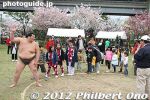
Train around the sumo ring.
|
|
|
|
|
|
|
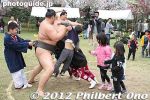
One rascal kid is trying to undo the wrestler's mawashi.
|
|
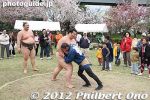
This thin man challenged the sumotori.
|
|
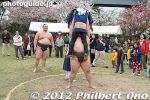
He was lifted up and out.
|
|
|
|

Special viewing window called "sajiki-mado" at Hino Matsuri. They view the Hino Festival procession from this special window. 桟敷窓
|
|

Then the children's sumo matches. Boys only, no girls. This was the main highlight and crowd pleaser.
|
|
|
|
|
|
|

The winners received various household and kitchen goods like towels, pillows, toaster, etc.
|
|
|

It wasn't so crowded. There were some photographers, and it received local TV news coverage.
|
|

The children's sumo were based on age. And they got older.
|
|
|
|
|
|
|

A pillow for this winner.
|
|

Odo-ren 乙奴連
|
|

Takarabune-ren from Mitaka. 寳船連
|
|
|
|
|
|
|
|
|

Iga-Ueno's Ueno Park includes this beautiful building called the Haisei-den (俳聖殿), a hall dedicated to Haiku poet Matsuo Basho who was from Iga-Ueno.
|
|

A short walk from Iga-Ueno Castle and almost next to the ninja house, the Haisei-den was built in 1942 to mark the 300th anniversary of Basho's birth.
|
|

The building was designed by architect Ito Chota (1867-1954) (伊東 忠太) who designed numerous shrine and temple buildings in the 1920s and '30s, including Tsukiji Hongwanji temple in Tokyo.
|
|

The Haisei-den was designed to look like Basho in travel clothing. The top roof resembles a hat, and the lower roof resembles his straw raincoat. Cherry blossoms were in bloom.
|
|
|

Haisei-den and wisteria in bloom. The Basho Matsuri Festival is a poetry reading held here on Oct. 12.
|
|

Inside the Haisei-den is a ceramic statue of Basho.
|
|

Iga-yaki ceramic statue of Basho inside the Haisei-den.
|
|

A short walk from Ueno Park is the Basho Oseika (芭蕉翁生家) or Basho's childhood home. Iga is the birthplace of Matsuo Basho (1644-1694), and the house where he grew up in still stands.
|
|

The house is open to the public as a tourist attraction (admission 300 yen). The house was rebuilt after it being damaged by a large earthquake in 1854.
|
|

Room inside Basho's childhood home.
|
|
|

Small door to the kitchen. People must have been pretty short then.
|
|

Kitchen area with a well on the left and stoves toward the right.
|
|
|

Water well
|
|

Kitchen stoves
|
|
|
|

Toilets and bath
|
|

Urinal
|
|
|

The back of the house is Basho's study called Chogetsuken (釣月軒) where he wrote the Kai-ooi (貝おほい) series of poems.
|
|

Inside the Chogetsuken study. 釣月軒
|
|

The study is a very simple, yet aesthetic and meditative-looking room.
|
|
|

Statue of Basho at Ueno-shi Station.
|
|

Hanamatsuri Parade on April 8, Buddha's birthday.
|
|

Hanamatsuri Parade on April 8, Buddha's birthday.
|
|

Baby Blessings at Warabi Hadaka Matsuri in Yotsukaido, Chiba. Infants are blessed in front of the shrine.
|
|

Men Take Strands of Straw
|
|

A Man and a Baby at Warabi Hadaka Matsuri in Yotsukaido, Chiba.
|
|

Babies to Mud at Warabi Hadaka Matsuri in Yotsukaido, Chiba. The men carry babies to the mud paddy and use a straw strand to paint a dot on the baby. Sometimes they use a finger to do it.
|
|
|
|
|

Sacred Water (and Mud). On the the left, the water feeding the paddy is enclosed by a sacred rope. This makes the water (and mud) sacred.
|
|

All the baby-carrying men must be careful not to slip and fall in the mud. Warabi Hadaka Matsuri in Yotsukaido, Chiba.
|
|

Mud Spotting, Warabi Hadaka Matsuri in Yotsukaido, Chiba. The men hold babies and use mud to paint a mud spot on the baby's face. It is to wish for happiness for the baby.
|
|

Some babies wear beautiful kimono for the occasion.
|
|

The festival is also nicknamed "Doronko Matsuri" which means Mud Festival.
|
|

Mud for All Ages
|
|

Mud Brings Happiness, at Warabi Hadaka Matsuri in Yotsukaido, Chiba.
|
|
|
|